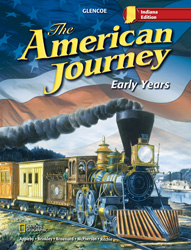

The American Journey Early Years © 2010 Indiana EditionChapter 2: Exploring the AmericasChapter OverviewsSection 1: A Changing World Western Europe was isolated from the rest of the world for centuries after the fall of the Roman Empire. Then in the 1300s, the Renaissance began in the Italian city-states and spread throughout Europe. Nation-states emerged with strong monarchs, eager to make even greater profits by increasing trade. Advances in technology, such as the compass, produced better means of navigation and paved the way for European exploration. Portugal sailed south along the western coast of Africa, setting up trading posts along the way. In Africa, the powerful empires of Ghana, Mali, and Songhai sold gold and enslaved people to the Portuguese. Section 2: Early Exploration Portugal, lacking a port on the Mediterranean, took the lead in finding a sea route to India by sailing south and east around the tip of Africa. Sponsored by Queen Isabella of Spain, Christopher Columbus sailed west and reached the Americas, although he thought he had arrived in India. Both Spain and Portugal wanted to protect their claims, and so agreed to divide control of the world using an imaginary line running through the middle of the Atlantic Ocean. Section 3: Spain in America Early Spanish conquistadors received grants from Spanish rulers to explore and establish settlements in the Americas. European explorers found new lands and conquered Native American empires, including the Aztec and Inca Empires. The Europeans had the advantage of fighting with horses, guns, and cannons. The diseases that came with the Europeans were deadly to the Native Americans. A strict social class structure developed in the Spanish colonies in the Americas. Spanish-born peninsulares were at the top, followed by the creoles, mestizos, Native Americans, and finally, enslaved Africans. In an effort to save Native Americans from plantation work, the Spanish priest, Bartlomé de Las Casas, suggested replacing them with enslaved Africans. As a result, many more Africans were brought to the Americas and slave labor became an essential part of the colonial economy. Section 4: Exploring North America Europeans sent out explorers to spread Christianity, but a religious upheaval – sparked by the protests of Martin Luther and John Calvin -- was causing religious divisions at home. During the 1600s, Protestantism grew to become a powerful religious force in Europe. The religious upheaval also divided the settlements in the Americas. In addition to spreading Christianity, European nations hoped to increase their wealth by acquiring gold and other riches from the colonies. This desire led to increased rivalries between countries. Many disregarded Spain and Portugal’s agreement to divide the world between the two of them. |  |















